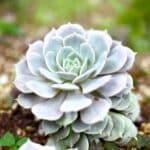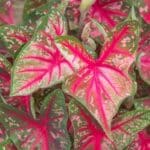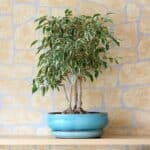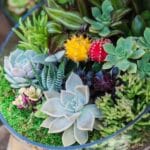Also known as monstera esqueleto, monstera epipremnoides is one of the newest monstera varieties on the block and is becoming incredibly popular.
If you love monstera adansonii, then you will certainly this variety as well because their leaves look pretty much alike, only that monstera epipremnoide’s leaves are bigger.
Monstera epipremnoides leaves are also slender and pointed just like the leaves of monstera adansonii – and they also have a similar fenestration pattern. This plant is absolutely remarkable and a must-have for every serious monstera collector or someone that just want to have another monstera variety in his garden.
While monstera epipremnoides can be expensive and difficult to find (though not as costly as monstera obliqua), it’s somewhat easy to take care of, especially if you already have some experience with other types of monstera and aroids in general.
Table of Contents
What Is Monstera Epipremnoides? | Monstera Epipremnoides Origin
| Botanical Name | Monstera epipremnoides |
| Other Names | Monstera esqueleto |
| Family | Araceae |
| Genus | Monstera |
| Plant Type | Perennial |
| Native | Costa Rica |
| Soil Type | Well drained but moist, rich organic mix |
| Mature Size | It grows up to 13 ft tal when fully matured |
| Soil PH | Acidic, neutral |
| Hardiness Zones | 9b -11 USA |
| Toxicity | Toxic to pets |
Also known as Monstera Esqueleto, Monstera Epipremnoides is an attractive flowering evergreen houseplant from Araceae, the arum family. The plant is native to Costa Rica.
It is a wider variety of the Monstera Adansonii because of its leaf size, which is quite a little bigger than that of the common Adansonii variety but just like holey. As the saying goes, "Rome wasn't built in a day," neither can a lush and attractive home garden be.
Therefore, it requires a little patience and utmost care, like watering, proper lighting, and proper humidity, amongst others; only then will your plant grow into the astounding frame you desire.
We bring you the care tips for the Monstera Epipremnoides.
Monstera Epipremnoides Care and Growing Tips
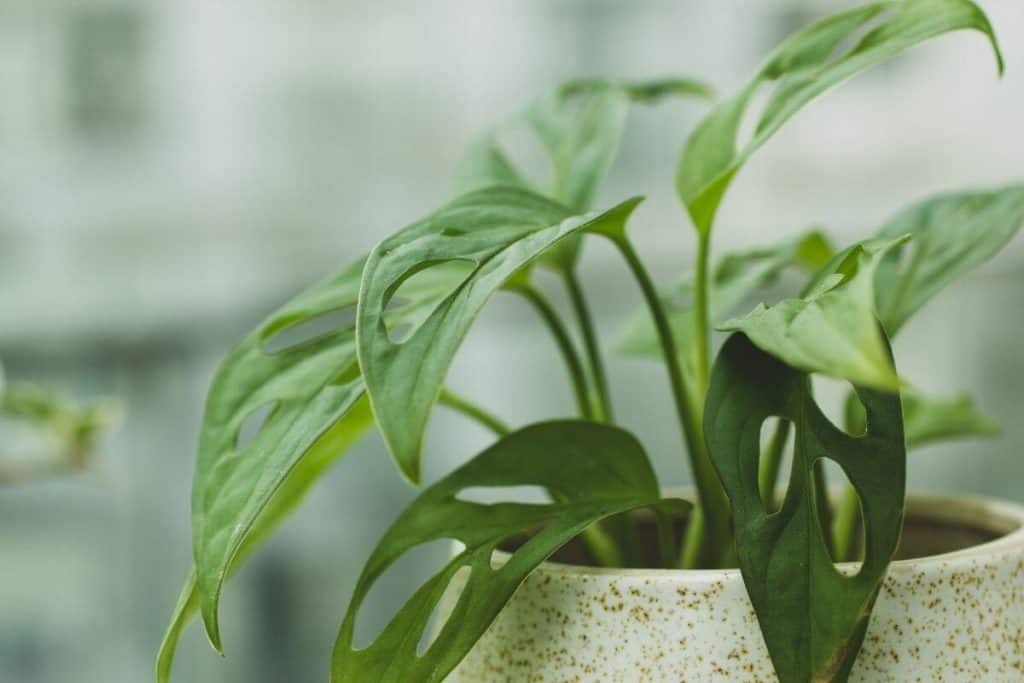
Natural Habitat
Like every other Monstera variety, the Monstera Epipremnoides is a tropical plant, although different varieties originate from various tropical rainforests worldwide.
The Monstera Epipremnoides originated from Costa Rica, which is why it can thrive in most indoor conditions.
It is originally used in the mountainous regions of Costa Rica, where for most periods of the year, early mornings provide dark mist and high levels of moisture, and afternoons are extremely hot and humid.
They grow happily surrounded by the dappled shade of other tropical foliage; therefore, they are accustomed to extended periods with only indirect sunlight as their primary energy source.
However, you may apply more care and caution when the plant is new to your home, as it is planning to keep up or get used to the new surroundings, and other things like watering, soil, light, temperature, etc., might take a long time.
Related Post: Split Leaf Philodendron Care
Light Requirements
Originally in Costa Rica, the Monstera Epipremnoides grow beneath their forest canopies. In other words, even the wild outdoor species do well when receiving the indirect sun. You can replicate a similar environment indoors.
Locate a room that gets sunlight and keep your Monstera Epipremnoides adjacent to the area so that it stays in the brightness but not in the scorching sunrays.
Although few hours under the sun's direct heat won't result in any disastrous effect, anything longer than 6 hours can burn the leaves.
It will also definitely diminish the beauty and health of your plant. Even in nurseries, the plant is grown under the shades.
Therefore, the best condition for it is under bright indirect sunlight. You can use a nice LED lamp for dark rooms and place it close to the plant; it will also thrive.
Watering Requirements
It is very important not to forget that the Monstera Epipremnoides doesn't need to be watered every day. Unlike many other plants, this variety doesn't require excessive watering every day or several times a week; rather, watering once a week is okay.
Again, before you water, you have to consider the nature of the soil before you water it. We will talk about that later in the soil requirements tips.
Meanwhile, after checking the soil, and it is still wet, then wait for the next day, and check again until it's almost dried because watering more than it needs, will cause the root to rot, and your plant will gradually die.
The method of checking the wetness of the soil is by sticking your finger inside, and if around an inch below, you discover the soil is dry, then you can water it; if it's not, there's no need of watering.
Also, while watering, ensure a drainage hole underneath where you can see the water running off. In other words, every excess liquid needs to run off, as Monstera Epipremnoides doesn't like wet feet.
It's very necessary to avoid newly poured tap water because it contains fluoride, which, to some extent, can be toxic to the plant.
You are free to leave it overnight and then water your plant the next day, but do not be in a hurry to do it.
The perfect option would be distilled water or rainwater if you can fetch it. If there's one care factor of the Monstera to take seriously, it is the watering aspect to avoid inadvertently damaging it.
Humidity & Temperature
Just like other Monstera varieties, the Monstera Epipremnoides do best in high humidity. If the location of your house or office where your plant is kept is not a humid environment, you can use a humidifier, a pebble tray below the plant pot, or mist daily to allow for enough humidity.
Another obvious option is to plant many houseplants closely together. By doing, it will create a humid microclimate suitable for your Monstera Epipremnoides.
Temperature-wise, Monstera Epipremnoides can survive outdoors in USDA hardiness zones from 9b -11.
Temperatures should be maintained within the range of 55°F to 80°F (13°C to 27°C). At times, the plant thrives in mild to cold temperatures because it originated from high elevations.
Monstera Epipremnoides Soil Requirements
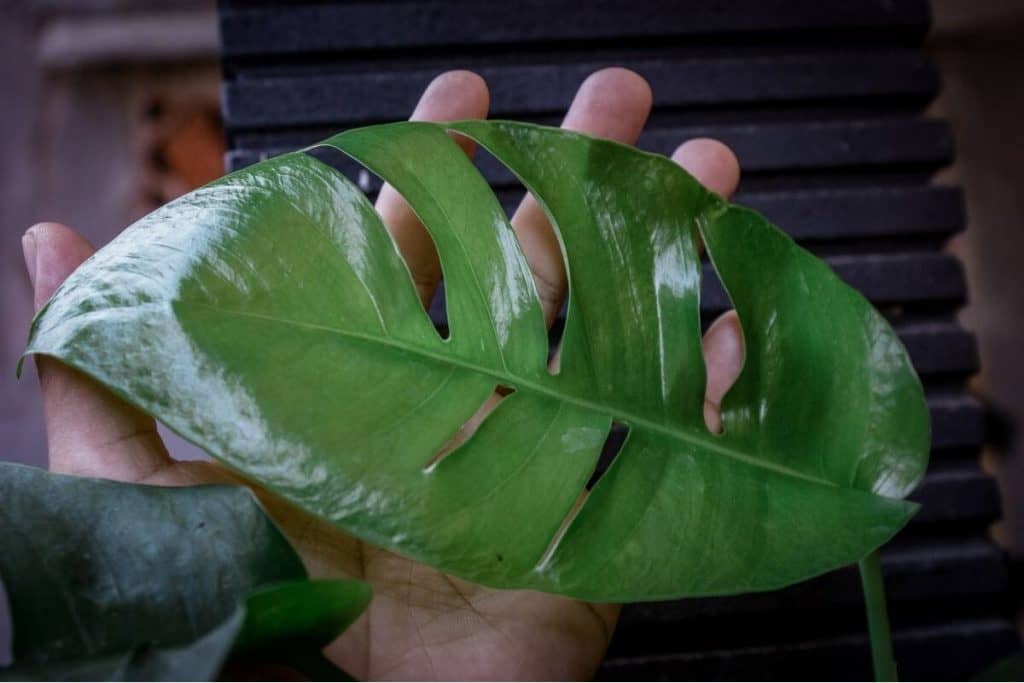
In its native environment, Monstera Epipremnoides thrives in soil rich in nutrients and well-draining.
Therefore, for your plant's healthy growth and survival, do not use any soil that conserves moisture for any duration of time because these plants will not accept damp roots.
Meanwhile, the extended time you expose it to damp soil will only result in irreversible damage to the roots of your Monstera houseplant.
So, the best idea will be to use a peat-based potting mix combined with perlite or charcoal, bark, and composted animal matter, which will help to provide both a speedy draining environment and one that is filled with nutrients.
There are several good quality, well-draining potting mixes readily obtainable to purchase online at an affordable price.
You can also go for a purpose-made Potting Soil from Monstera Plant Resource Center, and it is available to purchase at Amazon. You can search for them online using their link.
Again, whenever you want to improve on the well-draining element needed for these plants, always ensure that you grow your Monstera Epipremnoides in a pot that possesses a good-sized drainage hole.
Fertilizing Monstera Epipremnoides
The Epipremnoides Monstera doesn't need regular fertilizer application, yet, it certainly needs high-quality food.
Feeding them with the common cheaper products around has some implications, as they always contain heavy salts, which can damage the roots and eventually lead to a dead plant.
You are required to feed them at least three times a year. You can skip feeding Monstera Epipremnoides completely, and they will still grow, although slowly, but the required three times a year feeding with the recommended dosage is perfect for the good health and growth of the plant.
There are several varieties of fertilizers around, but to ensure a positive result, we recommend a slow-release granular type, enabling the plant to receive the nutrients gradually.
If you happen to picture those with salt build-ups, you can still clean them to avoid subsequent problems, yet, we still advise you to go for the best or high-quality fertilizer to avoid any impending disaster that may hamper the proper growth of your plant.
If you have decided on going for the liquid fertilizer, be mindful of its NPK, and ensure they are balanced. The NPK is used to show the amount of some crucial macro-nutrients- nitrogen, phosphorus, and potassium.
Monstera epipremnoides like magnesium (Mg); therefore, choose the one that comes with a good level of Mg too.
For proper application, follow the instructions for diluting, and avoid making a "stronger" one just because you feel your plant desires a heavy drink. It doesn't work that way, as you'll only be endangering it.
When you are done feeding them, you can pour some water to reduce the shock, which will absorb the nutrients even better.
Related Post: Difference Between Monstera Adansonii and Deliciosa
Planting (Potting & Repotting) of Monstera Epipremnoides
Monstera Epipremnoides is a slow-growing plant; hence, it is only required to be repotted once in a while. Like other Monstera plants, this variety is renowned for facing stress after undergoing the repotting experience, as it can easily damage their roots.
It is important to minimize the way you report your Monstera plants, and even when reporting, you have to be as careful as possible. We have highlighted several guidelines that will show you how to go about it for the proper growth of your plant.
- Make sure you do the repotting during the growing season. A Monstera that is actively growing will stand the greatest chance of recovering from any stress.
- Water your Monstera and then wait two days before repotting it. Damp roots will be softened and easier to remove from the edges of the pot, which will help prevent root damage.
- Don't pull on the stems of your Monstera plant because they can become easily damaged. Instead, tip the pot on its side and loosen the soil around the edges of the pot using your finger. It will make it easier to slide the plant from the pot or container.
- Brush away as much soil as possible from the roots. Use a soft brush or your fingers to do this and avoid damaging roots.
- While the roots are exposed, have a good look for any signs of damage or disease. You want roots that are firm to the touch and cream or white rather than brown and mushy.
- When you repot your Monstera choose a pot or container that is slighter larger than the last and has good-sized drainage holes. Clay or terracotta are great at helping draw moisture away from the soil and help further with drainage.
- Bury roots and just enough stem for the plant to be stable enough to stand upright. Press the soil up and around the stem to help with support.
- Always replace the soil with fresh well-draining potting soil and do not fertilize your Monstera for at least four months once you have re-planted it. Fresh soil will already contain a healthy dose of nutrients, and any more may be excessive for your plant to absorb.
Expect your Monstera to take a few weeks to recover and settle back into a slightly larger environment.
The stress of being disrupted will subside, and your plant should bounce back once the stress of being disrupted has subsided, and you'll begin to see new growth within a month or so.
How to Prune Monstera Epipremnoides
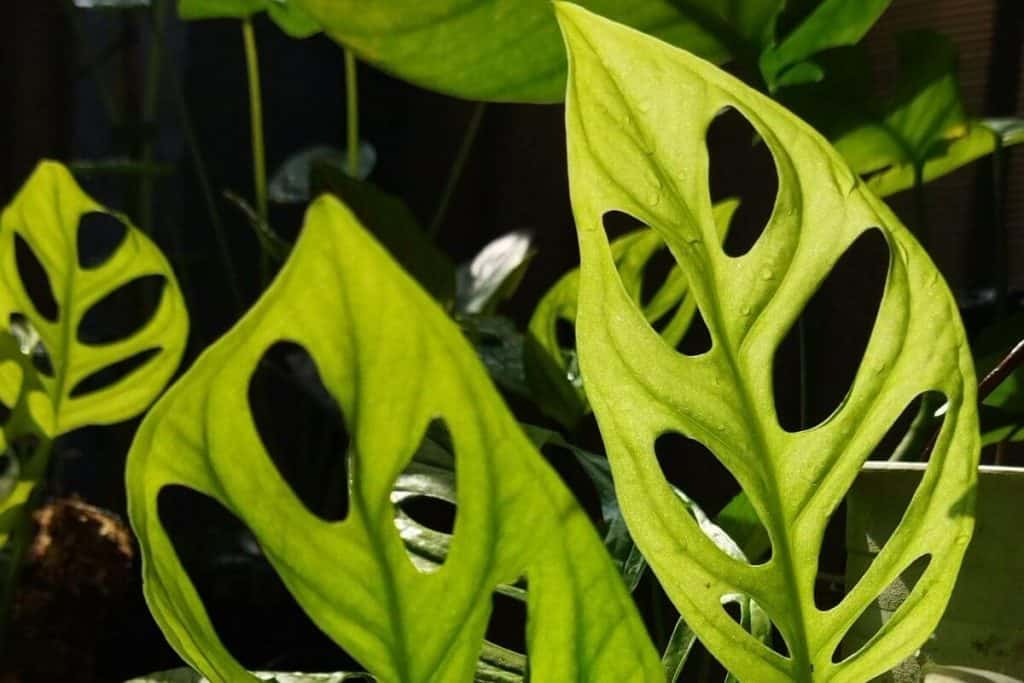
The Monstera Epipremnoides don't require pruning at all. Even if you discover some leaves turning yellow, rather than prune them off, it is not a bad idea to find and use some other solutions that will get them back to life, except you plan on losing the attractive leaves of this plant.
How to Propagate Monstera Epipremnoides
Propagation refers to the multiplication of plant collection from cuttings of the parent plant. The Monstera Epipremnoides can be propagated using several methods, including the stem cutting method, air layering, and separation.
Here's a highlight of each of these propagation methods:
Propagation by Stem Cuttings
- Select a fairly young, healthy-looking section of the plant to propagate.
- Using sterilized pruning shears or a knife, cut off a section of 1-3 leaves, and make sure your cutting includes at least one node (this will appear like a little brown bump on the stem across from the base of a leaf).
- Place the cutting in a glass of clean water with a bit of Propagation Promoter and position the glass in a bright place.
- Replace the water and Propagation Promoter weekly. Within a few weeks, you should see new roots beginning to sprout.
- Once the roots have grown one inch long, plant the cutting in soil (or keep growing with hydroponic methods) and care for it like you would a mature plant.
Propagation by Air Layering
- Find a node right below the stem you wish to propagate and make a small cut in the stem near the node. (Endeavor to use clean hands and tools!)
- Wrap the cut area in damp sphagnum moss and cover the whole wad with plastic wrap secured with string or a twist tie. Make sure you don't tie it too tightly and allow some airflow, so the moss doesn't mold.
- Remove the plastic and rehydrate the moss with water in a spray bottle every few days before replacing the plastic. After a few months, you should see new roots.
- When the roots are an inch long, cut off the entire section and plant directly into the soil or a hydroponic growing medium.
Propagation by Separation
Propagation by separation method is the best choice if your monstera epipremnoides is growing too large for its pot, yet, you don't want to go up a size. Therefore, the separation demands that you:
- Carefully remove the plant from the pot by tipping it on its side and using gravity to coax it out gently.
- Massage the root ball to break up the soil, and use your fingers to untangle the roots, separating your Monstera into two or more plants. If the roots are tightly wrapped, you can also use a sharp, clean knife or shears to cut the root ball into sections.
- Pot the sections into their pots, and the task is completed.
FAQs About Monstera Epipremnoides
How do you identify Monstera Epipremnoides?
Monstera Epipremnoides can be identified by its leaf size, leaf color, and the perforations. The plant has bigger and lighter green colored leaves with a leathery feel and perforations that start on the midrib and reach all the way through the edge of the leaves.
How do you care for Monstera Epipremnoides?
Caring for monstera epipremnoides is easy and only requires you to give it the soil, watering, sunlight, and prune it when necessary.
Why is Monstera esqueleto expensive?
Monstera esqueleto is expensive because it’s very high in demand and difficult to get. And this is due to its beautiful appearance and stunning leaves, which looks like a larger version of the more common monstera Adansonii.
How much does a Monstera Epipremnoides cost?
Prices may vary depending on where you live. But a small monstera esqueleto (Monstera Epipremnoides) can go anywhere from $100 to $500 online or from most rare plant shops.
What the difference between Monstera Adansonii and Monstera Epipremnoides?
The biggest differences between monstera epipremnoides vs monstera adansonii are the leaf size, the leaf color and the perforations. Monstera Epipremnoides leaves are much bigger compared to that of Monstera Adansonii.
Related Post: Difference Between Monstera Obliqua and Adansonii

